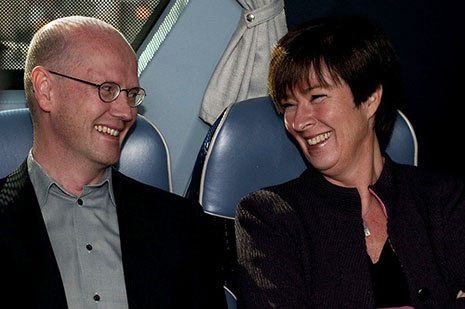IN MANY PARTS of Sweden, wearing a peaked keps (cap) is a symbol of belonging to the “ordinary” people rather than being part of the political and economic establishment in Stockholm. Many young Swedish men from working-class families wear their caps with the peak towards the neck; their fathers prefer the way it always was, with the peak to the front. But if the generations’ style is diverging, what is going on under their headgear is converging: the historic ties of everyday Swedish men to the party that once commanded their loyalty – the Social Democrats – are loosening.
The result of Sweden’s election last weekend seems to confirm this shift, at once rational and emotional. The election was won by the centre-right Alliance for Sweden, headed by Fredrik Reinfeldt, Sweden’s prime minister since 2006. Reinfeldt’s Moderates took 30 per cent of the vote, double their share in 2002. The three other parties in the four-party coalition – the Centre Party (6.6 per cent), the Liberal People’s Party (7.1 per cent), and the Christian Democrats (5.6 per cent) – lost ground but still contributed vital seats to the Alliance’s total. Together, the Alliance has 173 seats, just two short of a majority in the 349-seat Riksdag.
The opposition Social Democrats won 30.9 per cent of the votes. This may be slightly more than the Moderates, but even adding in its allies in the “red-green” coalition – the Green Party (7.2 per cent) and the ex-communist Left Party (5.6 per cent) – the joint 43.7 per cent support is way behind the Alliance’s 49.3 per cent. For the Social Democrats, which have governed Sweden for sixty-five of the seventy-eight years since 1932, it is a successive bitter defeat.
Unless there is some wholly unexpected reconfiguring of the parties, the likelihood is that the centre-right Alliance will hold on to power. But it must be stressed that since there is now no clear governing majority in an eight-party parliament, the final shape of the next government remains unclear.
If the Moderate-led government does indeed stay in power this will be a historic election – the first time a centre-right government has been re-elected in Sweden after serving a full term. But the election is also notable for the entry into parliament of the anti-immigration Sweden Democrats, which received 5.7 per cent of the votes (far ahead of the 4 per cent threshold needed to qualify for seats).
Of the many stories in this election, the failure of the Social Democrats and the advance of the Sweden Democrats are the most striking. They are also linked. Polls published before the election indicated that younger men in less affluent areas (and working-class people in general) were preparing to abandon the Social Democrats. Although they also took votes from the right, the Sweden Democrats were a beneficiary of this trend. The result amounts to an identity crisis for a party that long commanded Sweden’s political stage, and reveals a political problem for Swedish society as a whole.
Two days before the election, I witnessed a visit by Thomas Östros to his old school in the industrial town of Västerås. More than a hundred first-time voters – including a good number of young guys with regulation keps – were gathered to hear this top-level Social Democrat and party spokesman for economic policy make his case, which he does in a way that’s far from the technocratic image sometimes ascribed to him. Östros argues against the centre-right government’s policy of lowering taxes and social benefits, and in favour of lifelong learning that gives everybody a chance.
He also talks about his personal history as the son of a quarry worker and a cleaner. The free schooling he shared with all Swedish children enabled him to go on to university and later to economic research. When a girl asks about post-school education, Östros’s answer refers to the small university just a hundred metres away, built under the Social Democrats as part of a nationwide education policy. Even the boys at the back seem to be listening carefully.
In a way, Östros’s personal biography is also the story of Swedish social democracy, one that reveals the possibilities that, in principle, are open to all children. A comparable tale is told by another Social Democrat member of parliament, Luciano Astudillo, the Swedish politician who perhaps most closely resembles Barack Obama. In a blog post written just after the election, Astudillo described his arrival in Sweden from Chile as part of a family of political refugees: “It’s a fantastic story, in a way. Can you imagine that a little boy born in a foreign land, who grew up in one of Sweden’s poor areas, had the chance to be a member of the country’s most important political assembly? That’s the Sweden I love.”
These individual careers may reflect the success of Social Democrat encouragement of social mobility, but the theme no longer seems to resonate with all industrial and service workers and their families. In the Västerås district of Råby, where Östros once lived, the Sweden Democrats tripled their support compared to 2006.
The defection of some working-class voters from the Social Democrats to the Sweden Democrats is a phenomenon that links the economy, immigration and social change. The face of Sweden has been transformed by immigration. In proportion to its population, it is among the top recipients of refugees in the European Union (the contrast with its neighbours Denmark and Finland is sharp); immigrants now compose 14 per cent of the national population of 9.4 million.
The established political parties have been slow in developing policies that can ease newcomers’ integration into the labour market, and in addressing more general issues of social adaptation. Far-right groups are eager to exploit this situation by attributing social problems and discontent to the immigrant presence (with a particular focus on the “threat” of Muslim immigrants to the Swedish way of life).
Yet Sweden’s healthcare, transport and industrial production are to a large extent dependent for their functioning on low-paid immigrant workers. Most public attention (including media coverage) tends to concentrate not on such “routine” aspects of a multicultural society, though, but on issues such as the high levels of unemployment and violence in the suburbs where many people of non-Swedish background live. The established parties did not want to discuss immigration in the run-up to the election, out of fear that such a debate would favour the Sweden Democrats; a re-evaluation of this approach will undoubtedly be a key part of the post-election debate.
Göran Persson, the Social Democrats’ last prime minister (1996–2006), regarded the social exclusion of immigrants as one of his government’s two main political challenges. But the party never implemented an effective strategy to improve living conditions in poor areas. Since the centre-right government came to power in 2006, social differences have increased further. This is partly the result of official policy: resources for healthcare have been transferred from deprived to more prosperous areas, and money designated for schools with many pupils of non-Swedish origin has disappeared even as more immigrants arrive.
The bastion of the Sweden Democrats has been the south of Sweden, where their support rose substantially in this election; but the party also gained votes in some of the Social Democrats’ strongest footholds, such as the old industrial areas in central Sweden. This resembles what has happened in other parts of Europe where populist far-right parties have made gains, and it poses a great long-term danger to the Social Democrats.
WHEN I talked to Thomas Östros in Västerås, he suggested that the Sweden Democrats’ ability to recruit voters is helped by both an overall distrust of politics and, for some, a loss of confidence that they will be successful in life. This combination of cynicism and social exclusion helps to fuel the party’s growth (though it should be noted that the party also attracts middle-class voters). Östros blames the centre-right government for increasing social and income differences, but also acknowledged that such differences, and problems with social segregation, have existed for a long time.
The Social Democrats’ failure to capitalise on these growing gulfs can also be seen in the fact that a substantial segment of its core political base, working-class men, voted for the centre-right Moderates. This trend fits with Reinfeldt’s repositioning of his party. Before the 2006 election he rebranded the conservative party as the “New Moderates” (on the model of Tony Blair’s “New Labour”); during this campaign he went further, describing his movement as “Sweden’s only party for workers.”
Among some, at least, it worked. Reinfeldt’s tax-reduction program (amounting to the equivalent of over A$16 billion a year) might have benefited mostly the affluent, but the Moderates’ advance into the Social Democrats’ traditional base confirms that the party is no longer the automatic choice of working-class families. As Irene Wennemo, a former senior trade unionist, writes in a post-election analysis in the newspaper Aftonbladet, “The Moderate Party has successfully exploited the fact that many people feel themselves to be workers at their job, but as middle-class at home.”
The Social Democrats also lost support among urban middle-class voters, a trend already visible in 2006. The disappointment here is sharp, as the post-2006 renewal process launched by the party’s new leader, Mona Sahlin, largely focused on winning back these voters. This strategy led the Social Democrats to avoid proposing measures that might alienate this group (such as substantial tax rises and restrictions on choice between different schools or healthcare centres).
It did not work. The urban middle-class heartland of voters presumed to be more individualistic and comfortable with public-service competition (introduced mainly by the centre-right) remained impervious to the Social Democrats’ appeal. In the post-election debate already under way, party figures such as Helene Hellmark Knutsson are saying that these reforms did not go far enough and the Social Democrats should carry them forward; others reject the notion that copying policies pioneered by the centre-right is the way to secure support from this group of voters.
Another common explanation for the poor result of the Social Democrats is that voters are used to the party being in government alone, and suspicious about the plan to form a coalition with the Greens and the Left Party.
More broadly, the identity crisis of the Social Democrats in Sweden – as in other parts of Europe – seems to be linked to the division between today’s new working class and urban middle-class voters in the context of a multicultural society. A political message directed towards the middle class in the big cities does not seem to work, least of all for men in working-class families.
But the good performance of the centre-right is not due solely, or even mainly, to the weakness of the Social Democrats. The credit also belongs to the success of prime minister Fredrik Reinfeldt in holding his four-party coalition together, in contrast to earlier centre-right governments. The opinion polls also show a high degree of confidence in the key governmental figures (Reinfeldt himself, finance minister Anders Borg, and foreign minister Carl Bildt), whereas confidence in Mona Sahlin is low.
Sweden’s public finances are in good shape, in spite of the global financial crisis and high unemployment. This is largely the result of the low public debt the centre-right inherited when it came to power in 2006, though Fredrik Reinfeldt’s government is perceived to have handled the public finances well during the global financial crisis. Now, the Swedish economy is recovering quickly, with GDP growth projected to reach 4 per cent in 2010. With economic conditions in other parts of Europe still very uncertain, this has contributed to a reluctance among many voters to opt for change.
What is surprising, however, is that an unemployment rate of over 8 per cent has not led to a greater boost for the Social Democrats, the party that Swedish voters have historically trusted to ensure high employment levels. But a change of sentiment in this respect was already apparent in 2006, when many Swedes reacted with astonishment to Göran Persson’s famous (or notorious) comment that unemployment was not a big problem. That helped the Moderates to establish greater credibility among voters on the jobs issue – a position they retained in 2010. This is a disaster for the Social Democrats.
At the same time, the centre-right parties faced severe criticism for the government’s harsh reductions of benefits to the sick and unemployed. A number of people with cancer and other serious illnesses have even been forced to work, which has led to the government being portrayed as inhuman.
But some voters also sympathise with the argument for reducing Sweden’s generous welfare benefits. During Thomas Östros’s presentation at his old school, a young man asked why people should receive such high unemployment benefits. Doesn’t that reduce the motivation to find a new job? That kind of question might have a certain resonance among traditional Social Democrat voters where there is still a strong work ethic.
Östros’s counter-argument is more effective than those of most other senior politicians: “My father was a rock-blaster. We had just moved to the first house the family owned, in this town, when he lost his job. If there had not been a social-security system in Sweden, our situation would have been completely different and far worse. That helped him to find a new job after some time.” Östros also knows and can explain why the Swedish model is effective from a macroeconomic point of view – because it has facilitated modernisation of the economy at a time of global change.
There is still strong support in Sweden for the country’s welfare system. The Moderates were able to win the election in 2006 only by pledging to maintain high-quality welfare and (by international standards) high taxes – and the same is true four years later.
In this sense the identity crisis for Sweden’s Social Democrats is more one for the party than for its traditional values. Its ability to recover depends on whether it can persuade today’s young Swedish men – whatever their fashion in headgear – that Thomas Östros’s personal story is still relevant in a changing, multicultural society. •




